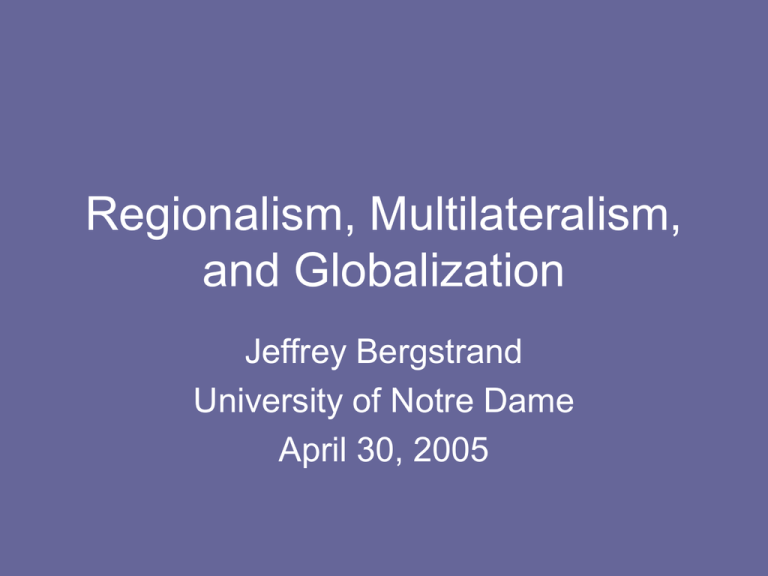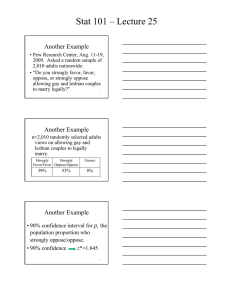Regionalism, Multilateralism, and Globalization Jeffrey Bergstrand University of Notre Dame
advertisement

Regionalism, Multilateralism, and Globalization Jeffrey Bergstrand University of Notre Dame April 30, 2005 The Survey of Workers • Question 1 (Questions 1-16): In general, do you strongly favor, weakly favor, weakly oppose, strongly oppose policies aimed at increasing trade with Canada? …… with France? …… with China? The Survey of Workers • Question 2 (Questions 17-32): In general, do you strongly favor, weakly favor, weakly oppose, strongly oppose policies aimed at increasing investment with Canada? …… with France? …… with China? The Survey of Workers • Question 3 (Questions 33-48): In general, do you strongly favor, weakly favor, weakly oppose, strongly oppose policies aimed at increasing immigration with Canada? …… with France? …… with China? The Survey of Firms • Question 1 (Questions 1-16): In general, do you strongly favor, weakly favor, weakly oppose, strongly oppose policies aimed at increasing trade with Canada? …… with France? …… with China? The Survey of Firms • Question 2 (Questions 17-32): In general, do you strongly favor, weakly favor, weakly oppose, strongly oppose policies aimed at increasing investment with Canada? …… with France? …… with China? The Survey of Firms • Question 3 (Questions 33-48): In general, do you strongly favor, weakly favor, weakly oppose, strongly oppose policies aimed at increasing immigration with Canada? …… with France? …… with China? I. What is Globalization? • Create a Survey Instrument that is “Based on Theory.” • Create a Survey Instrument that is “Based on Theory.” • However, such a theory should reflect how consumers and firm leaders think. • Create a Survey Instrument that is Theory.” “Based on • However, such a theory should reflect how consumers and firm leaders think. • GE: 1. Market Access 2. Relative Costs 3. Trade and Investment Costs Theoretical Model Outline Goods • Differentiated final good • Homogeneous final good • Differentiated intermediates Firm Structure • 3-plant and 2-plant HMNEs • 1-plant VMNEs • 1-plant NEs Cost Structure • Plant vs. headquarters set-up costs (capital vs. skilled L) • Transaction costs (investment and trade) Key Differences • Three Factors: Add Physical Capital • Three “Goods”: Add Intermediates (or Outsourcing) • Three Countries: Add ROW (in order to understand Bilateral Flows in a Multilateral World) Key Implications The implications from a three-dimension theory can be vastly different than that from a two-dimension theory. Bilateral information provides much more heterogeneity of information than multilateral information. II. Goods and Services, Regionalism, and Multilateralism Robert Lawrence (1996, p. 5): The postwar experience with both multilateralism and regionalism has been mixed. On the one hand, the multilateral trading system has enjoyed spectacular success in lowering trade barriers on industrial products . . . . As the focus has shifted away from the relatively easy task of reducing barriers protecting industrial products, achieving agreement has become more difficult . . . . In many important areas, such as services and agriculture, liberalization has remained fairly limited. The Dilemma • “Multilateralism” has effectively been a “secondbest” policy. It has achieved wide breadth of country coverage, but more limited sectoral breadth (e.g., industrial goods). • “Regionalism,” of course, is also a second-best policy. Major regional trade accords (e.g., EU) have much less breadth of country coverage, but in many cases have achieved greater sectoral breadth (e.g., goods and services.) Why Regionalism? • Ed Mansfield (2005, p. 2): “More generally, greater attention needs to be focused on why state leaders have displayed a particular preference for entering preferential trade arrangements. One possibility is that they do so to liberalize trade when faced with domestic obstacles to reducing trade barriers on a unilateral or multilateral basis.” Goods vs. Services • Services, historically, are more costly to trade than goods. • Services, historically, have been protected by governments from international competition more than goods. • See Figure 3 (last page of my memo). Key Implications • Economic Geography is not just critical to trade flows, investment flows, and migration flows. It is critical to the benefits and costs of trade policies. III. Panel Data • Labor micro-econometrics has generated many insights into refining estimation of average treatment effects of policies on outcomes. The same problems likely exist for trade policies and consumer/firms’ trade attitudes. In the absence of a budget constraint, a panel approach could yield econometric estimates less obfuscated by omitted variables and selection bias issues. IV. Various and Sundry Issues 1. Quantity vs. Quality (Bemoaning politicians’ arguments that trade creates “more jobs.”) 2. Trade Liberalization vs. Technological Change 3. Short-Run Adjustment Costs vs. Long-Run Benefits of Trade




